The Added Value of Musculoskeletal Simulation for the Study of Physical Performance in Military Tasks
Abstract
1. Introduction
2. Materials and Methods
2.1. Subjects
2.2. Measurement Setup
2.3. Measurement Protocol
- no extra mass (M0): boots and sport clothes (~2.27 kg [36]) + Xsens suit + agility suit (both suits together were 3.1 kg) + 0 kg extra mass;
- light extra mass (M1): M0 + 15.6 kg extra mass (5.2 kg on the front, 10.4 kg on the back);
- heavy extra mass (M2): M0 + 31.2 kg extra mass (15.6 kg on the front, 15.6 kg on the back).
2.4. Musculoskeletal Modeling Environment
2.4.1. Model Adaptations and Settings
2.4.2. Musculoskeletal Simulations
2.5. Data Analysis
2.5.1. Muscle Parameters
2.5.2. Kinematic Parameters
2.5.3. Statistical Analysis
3. Results
3.1. Completion Time and Heart Rate
3.2. Energy Expenditure
3.3. Muscle Parameters
3.4. Kinematic Parameters
4. Discussions
Supplementary Materials
Author Contributions
Funding
Institutional Review Board Statement
Informed Consent Statement
Data Availability Statement
Acknowledgments
Conflicts of Interest
References
- Knapik, J.J.; Reynolds, K.L.; Harman, E. Soldier Load Carriage: Historical, Physiological, Biomechanical, and Medical Aspects. Mil. Med. 2004, 169, 45–56. [Google Scholar] [CrossRef] [PubMed]
- Bossi, L.L.M.; Jones, M.L.H.; Kelly, A.; Tack, D.W. A Preliminary Investigation of the Effect of Protective Clothing Weight, Bulk and Stiffness on Combat Mobility Course Performance. Proc. Hum. Factors Ergon. Soc. 2016, 701–705. [Google Scholar] [CrossRef]
- Billing, D.C.; Silk, A.J.; Tofari, P.J.; Hunt, A.P. Effects of Military Load Carriage on Susceptibility to Enemy Fire During Tactical Combat Movements. J. Strength Cond. Res. 2015, 29, S134–S138. [Google Scholar] [CrossRef] [PubMed]
- Hunt, A.P.; Tofari, P.J.; Billing, D.C.; Silk, A.J. Tactical Combat Movements: Inter-Individual Variation in Performance Due to the Effects of Load Carriage. Ergonomics 2016, 59, 1232–1241. [Google Scholar] [CrossRef] [PubMed]
- Nindl, B.C. Strategies for Enhancing Military Physical Readiness in the 21st Century; United States Army War College: Philadelphia, PA, USA, 2012. [Google Scholar]
- Cain, S.M.; McGinnis, R.S.; Davidson, S.P.; Vitali, R.V.; Perkins, N.C.; McLean, S.G. Quantifying Performance and Effects of Load Carriage during a Challenging Balancing Task Using an Array of Wireless Inertial Sensors. Gait Posture 2016, 43, 65–69. [Google Scholar] [CrossRef]
- Vitali, R.V.; Cain, S.M.; Ojeda, L.V.; Potter, M.V.; Zaferiou, A.M.; Davidson, S.P.; Coyne, M.E.; Hancock, C.L.; Mendoza, A.; Stirling, L.A.; et al. Body-Worn IMU Array Reveals Effects of Load on Performance in an Outdoor Obstacle Course. PLoS ONE 2019, 14, e0214008. [Google Scholar] [CrossRef] [PubMed]
- Hasselquist, L.; Bensel, C.K.; Brown, M.L.; Donovan, M.P.O.; Gregorczyk, K.N.; Iii, A.A.A.; Kirk, J. Physiological, Biomechanical, and Maximal Performance Evaluations of Medium Rucksack Prototypes. DTIC Doc. 2013, ADA581919, 83. [Google Scholar]
- Loverro, K.L.; Brown, T.N.; Coyne, M.E.; Schiffman, J.M. Use of Body Armor Protection with Fighting Load Impacts Soldier Performance and Kinematics. Appl. Ergon. 2015, 46, 168–175. [Google Scholar] [CrossRef] [PubMed]
- Gijsbertse, K.; Linssen, L.; Woering, A.; Catoire, M. The Effects of Mass, Bulk and Stiffness of Personal Protective Equipment and Clothing on Physical Performance When Performing a Military Mobility Obstacle Course. Appl. Ergon. 2021, 95, 103448. [Google Scholar] [CrossRef]
- The Effects of Backpack Weight on the Biomechanics of Load Carriage. Available online: https://apps.dtic.mil/sti/citations/ADA377886 (accessed on 2 July 2021).
- Qu, X.; Yeo, J.C. Effects of Load Carriage and Fatigue on Gait Characteristics. J. Biomech. 2011, 44, 1259–1263. [Google Scholar] [CrossRef]
- Attwells, R.L.; Birrell, S.A.; Hooper, R.H.; Mansfield, N.J. Influence of Carrying Heavy Loads on Soldiers’ Posture, Movements and Gait. Ergonomics 2006, 49, 1527–1537. [Google Scholar] [CrossRef]
- Polcyn, A.; Bensel, C.; Harman, E.; Obusek, J.; Pandorf, C.; Frykman, P. Effects of Weight Carried by Soldiers: Combined Analysis of Four Studies on Maximal Performance, Physiology, and Biomechanics; US Army Research Institute of Environmental Medicine: Natick, MA, USA, 2002; pp. 1–64. [Google Scholar]
- Rugelj, D.; Sevšek, F. The Effect of Load Mass and Its Placement on Postural Sway. Appl. Ergon. 2011, 42, 860–866. [Google Scholar] [CrossRef] [PubMed]
- Park, H.; Branson, D.; Petrova, A.; Peksoz, S.; Goad, C.; Warren, A.J.; Jacobson, B.; Kamenidis, P. Effects of Body Armor and Load Carriage on Lower Limb Joint Movement. J. Hum. Perform. Extrem. Environ. 2014, 10. [Google Scholar] [CrossRef]
- Wang, H.; Frame, J.; Ozimek, E.; Leib, D.; Dugan, E.L. The Effects of Load Carriage and Muscle Fatigue on Lower-Extremity Joint Mechanics. Res. Q. Exerc. Sport 2013, 84, 305–312. [Google Scholar] [CrossRef]
- Birrell, S.A.; Haslam, R.A. The Effect of Military Load Carriage on 3-D Lower Limb Kinematics and Spatiotemporal Parameters. Ergonomics 2009, 52, 1298–1304. [Google Scholar] [CrossRef]
- Quesada, P.M.; Mengelkoch, L.J.; Hale, R.C.; Simon, S.R. Biomechanical and Metabolic Effects of Varying Backpack Loading on Simulated Marching. Ergonomics 2000, 43, 293–309. [Google Scholar] [CrossRef]
- Silder, A.; Delp, S.L.; Besier, T. Men and Women Adopt Similar Walking Mechanics and Muscle Activation Patterns during Load Carriage. J. Biomech. 2013, 46, 2522–2528. [Google Scholar] [CrossRef] [PubMed]
- Looney, D.P.; Santee, W.R.; Blanchard, L.A.; Karis, A.J.; Carter, A.J.; Potter, A.W. Cardiorespiratory Responses to Heavy Military Load Carriage over Complex Terrain. Appl. Ergon. 2018, 73, 194–198. [Google Scholar] [CrossRef]
- Beekley, M.D.; Alt, J.; Buckley, C.M.; Duffey, M.; Crowder, T.A. Effects of Heavy Load Carriage during Constant-Speed, Simulated, Road Marching. Mil. Med. 2007, 172, 592–595. [Google Scholar] [CrossRef] [PubMed]
- Borghols, E.A.M.; Dresen, M.H.W.; Hollander, A.P. Influence of Heavy Weight Carrying on the Cardioresgiratory System during Exercise. Eur. J. Appl. Physiol. Occup. Physiol. 1978, 38, 161–169. [Google Scholar] [CrossRef] [PubMed]
- Grenier, J.G.; Peyrot, N.; Castells, J.; Oullion, R.; Messonnier, L.; Morin, J.B. Energy Cost and Mechanical Work of Walking during Load Carriage in Soldiers. Med. Sci. Sports Exerc. 2012, 44, 1131–1140. [Google Scholar] [CrossRef]
- Demczuk, V. Field Validation of an Energy Expenditure Model for Walking Soldiers. Int. J. Ind. Ergon. 1998, 22, 381–387. [Google Scholar] [CrossRef]
- Drain, J.; Billing, D.; Neesham-Smith, D.; Aisbett, B. Predicting Physiological Capacity of Human Load Carriage—A Review. Appl. Ergon. 2016, 52, 85–94. [Google Scholar] [CrossRef] [PubMed]
- Nakashima, M.; Hasegawa, T.; Matsuda, A.; Shimana, T.; Omori, K. 3D-CG Based Musculoskeletal Simulation for a Swimmer Wearing Competitive Swimwear. Procedia Eng. 2013, 60, 367–372. [Google Scholar] [CrossRef][Green Version]
- Stambolian, D.; Eltoukhy, M.; Asfour, S. Development and Validation of a Three Dimensional Dynamic Biomechanical Lifting Model for Lower Back Evaluation for Careful Box Placement. Int. J. Ind. Ergon. 2016, 54, 10–18. [Google Scholar] [CrossRef]
- Grujicic, M.; Pandurangan, B.; Xie, X.; Gramopadhye, A.K.; Wagner, D.; Ozen, M. Musculoskeletal Computational Analysis of the Influence of Car-Seat Design/Adjustments on Long-Distance Driving Fatigue. Int. J. Ind. Ergon. 2010, 40, 345–355. [Google Scholar] [CrossRef]
- Ardestani, M.M.; ZhenXian, C.; Noori-Dokht, H.; Moazen, M.; Jin, Z. Computational Analysis of Knee Joint Stability Following Total Knee Arthroplasty. J. Biomech. 2019, 86, 17–26. [Google Scholar] [CrossRef]
- Lenton, G.K. The Use of Kinematic and Kinetic Analysis Measurement to Identify the Critical Factors in Optimising Dismounted Combatant Load Sharing Systems. Ph.D. Thesis, Griffith University, Brisbane, Australia, 2017. [Google Scholar]
- Lenton, G.K.; Saxby, D.J.; Lloyd, D.G.; Billing, D.; Higgs, J.; Doyle, T.L.A. Primarily Hip-Borne Load Carriage Does Not Alter Biomechanical Risk Factors for Overuse Injuries in Soldiers. J. Sci. Med. Sport 2019, 22, 158–163. [Google Scholar] [CrossRef] [PubMed]
- Lenton, G.K.; Doyle, T.L.A.; Lloyd, D.G.; Higgs, J.; Billing, D.; Saxby, D.J. Lower-Limb Joint Work and Power Are Modulated during Load Carriage Based on Load Configuration and Walking Speed. J. Biomech. 2019, 83, 174–180. [Google Scholar] [CrossRef]
- Kelly, A.; Richter, M.; Tack, D.; Ueno, K.; TerHaar, P.; Wojtarowicz, D.; Bossi, L. Load Effects Assessment Program (LEAP): Creation, Evolution and Lessons Learned. Abstract and Poster Presentation. In Proceedings of the 3rd International Congress on Soldier Physical Performance (ICSPP), Boston, MA, USA, 18–21 August 2014. [Google Scholar]
- Richter, M. Marine Corps Load Effects Assessment Program. Abstract and Poster Presentation. In Proceedings of the 3rd International Congress on Soldier Physical Performance (ICSPP), Boston, MA, USA, 18–21 August 2014. [Google Scholar]
- Mitchell, K.B.; Batty, J.M.; Coyne, M.E.; Desimone, L.L. Reliability Analysis of Time to Complete the Obstacle Course Portion of the Load Effects Assessment Program (LEAP); U.S. Army Natick Soldier Research Development and Engineering Center: Natick, MA, USA, 2016. [Google Scholar]
- Bray-Miners, J. Soldier Innovation, Integration & Development—Load Effects Assessment Program—Operational Manual; HumanSystems Inc.: Guelph, ON, Canada, 2019. [Google Scholar]
- Fluit, R.; Andersen, M.S.; Kolk, S.; Verdonschot, N.; Koopman, H.F.J.M. Prediction of Ground Reaction Forces and Moments during Various Activities of Daily Living. J. Biomech. 2014, 47, 2321–2329. [Google Scholar] [CrossRef]
- Jung, Y.; Jung, M.; Lee, K.; Koo, S. Ground Reaction Force Estimation Using an Insole-Type Pressure Mat and Joint Kinematics during Walking. J. Biomech. 2014, 47, 2693–2699. [Google Scholar] [CrossRef] [PubMed]
- Margaria, R. Positive and Negative Work Performances and Their Efficiencies in Human Locomotion. Int. Z. Für Angew. Physiol. Einschließlich Arb. 1968, 25, 339–351. [Google Scholar] [CrossRef] [PubMed]
- Looney, D.P.; Potter, A.W.; Mcclung, H.L.; Welles, A.P.; Santee, W.R. Heavy External Loads Disproportionately Increase Walking Energy Expenditure; US Army Research Institute of Environmental Medicine (USARIEM): Natick, MA, USA, 2018. [Google Scholar]
- Bourdon, P.C.; Cardinale, M.; Murray, A.; Gastin, P.; Kellmann, M.; Varley, M.C.; Gabbett, T.J.; Coutts, A.J.; Burgess, D.J.; Gregson, W.; et al. Monitoring Athlete Training Loads: Consensus Statement. Int. J. Sports Physiol. Perform. 2017, 12, 161–170. [Google Scholar] [CrossRef]
- Umberger, B.R.; Gerritsen, K.G.M.; Martin, P.E. A Model of Human Muscle Energy Expenditure. Comput. Methods Biomech. Biomed. Eng. 2003, 6, 99–111. [Google Scholar] [CrossRef]
- Umberger, B.R. Stance and Swing Phase Costs in Human Walking. J. R. Soc. Interface 2010, 7, 1329–1340. [Google Scholar] [CrossRef]
- Bhargava, L.J.; Pandy, M.G.; Anderson, F.C. A Phenomenological Model for Estimating Metabolic Energy Consumption in Muscle Contraction. J. Biomech. 2004, 37, 81–88. [Google Scholar] [CrossRef]
- Lichtwark, G.A.; Wilson, A.M. A Modified Hill Muscle Model That Predicts Muscle Power Output and Efficiency during Sinusoidal Length Changes. J. Exp. Biol. 2005, 208, 2831–2843. [Google Scholar] [CrossRef]
- Zarrugh, M.Y.; Todd, F.N.; Ralston, H.J. Optimization of Energy Expenditure during Level Walking. Eur. J. Appl. Physiol. Occup. Physiol. 1974, 33, 293–306. [Google Scholar] [CrossRef]
- Minetti, A.E.; Alexander, R.M.N. A Theory of Metabolic Costs for Bipedal Gaits. J. Theor. Biol. 1997, 186, 467–476. [Google Scholar] [CrossRef]
- Houdijk, H.; Bobbert, M.F.; de Haan, A. Evaluation of a Hill Based Muscle Model for the Energy Cost and Efficiency of Muscular Contraction. J. Biomech. 2006, 39, 536–543. [Google Scholar] [CrossRef]
- Kim, J.H.; Roberts, D. A Joint-Space Numerical Model of Metabolic Energy Expenditure for Human Multibody Dynamic System. Int. J. Numer. Methods Biomed. Eng. 2015, 31, e02721. [Google Scholar] [CrossRef] [PubMed]
- Uchida, T.K.; Hicks, J.L.; Dembia, C.L.; Delp, S.L. Stretching Your Energetic Budget: How Tendon Compliance Affects the Metabolic Cost of Running. PLoS ONE 2016, 11, e0150378. [Google Scholar] [CrossRef]
- Hill, A.V. The Heat of Shortening and the Dynamic Constants of Muscle. Proc. R. Soc. London. Ser. B Biol. Sci. 1938, 126, 136–195. [Google Scholar] [CrossRef]
- Miller, R.H. A Comparison of Muscle Energy Models for Simulating Human Walking in Three Dimensions. J. Biomech. 2014, 47, 1373–1381. [Google Scholar] [CrossRef]
- Koelewijn, A.D.; Heinrich, D.; van den Bogert, A.J. Metabolic Cost Calculations of Gait Using Musculoskeletal Energy Models, a Comparison Study. BioRxiv 2019, 588590. [Google Scholar] [CrossRef]
- Mitchell, K.B.; DeSimone, L.; Brown, S.A.T. Impact of Physical Fatigue State on Military Mission Oriented Obstacle Course Timing Performance. Proc. Hum. Factors Ergon. Soc. Annu. Meet. 2018, 62, 1424–1428. [Google Scholar] [CrossRef]
- Callahan, D.M.; Umberger, B.R.; Kent, J.A. Mechanisms of in Vivo Muscle Fatigue in Humans: Investigating Age-Related Fatigue Resistance with a Computational Model. J. Physiol. 2016, 594, 3407–3421. [Google Scholar] [CrossRef] [PubMed]
- Friedl, K.E. Military Applications of Soldier Physiological Monitoring. J. Sci. Med. Sport 2018, 21, 1147–1153. [Google Scholar] [CrossRef]
- Mavor, M.P.; Ross, G.B.; Clouthier, A.L.; Karakolis, T.; Graham, R.B. Validation of an IMU Suit for Military-Based Tasks. Sensors 2020, 20, 4280. [Google Scholar] [CrossRef]
- Karatsidis, A.; Jung, M.; Schepers, H.M.; Bellusci, G.; de Zee, M.; Veltink, P.H.; Andersen, M.S. Predicting Kinetics Using Musculoskeletal Modeling and Inertial Motion Capture. arXiv 2018, arXiv:1801.01668. [Google Scholar]
- Karatsidis, A.; Jung, M.; Schepers, H.M.; Bellusci, G.; de Zee, M.; Veltink, P.H.; Andersen, M.S. Musculoskeletal Model-Based Inverse Dynamic Analysis under Ambulatory Conditions Using Inertial Motion Capture. Med Eng. Phys. 2019, 65, 68–77. [Google Scholar] [CrossRef]
- Skals, S.; Jung, M.K.; Damsgaard, M.; Andersen, M.S. Prediction of Ground Reaction Forces and Moments during Sports-Related Movements. Multibody Syst. Dyn. 2017, 39, 175–195. [Google Scholar] [CrossRef]
- Bustamante-Sánchez, Á.; Tornero-Aguilera, J.F.; Fernández-Elías, V.E.; Hormeño-Holgado, A.J.; Dalamitros, A.A.; Clemente-Suárez, V.J. Effect of Stress on Autonomic and Cardiovascular Systems in Military Population: A Systematic Review. Cardiol. Res. Pract. 2020, 2020. [Google Scholar] [CrossRef] [PubMed]
- Tornero-Aguilera, J.F.; Fernandez-Elias, V.E.; Clemente-Suárez, V.J. Ready for Combat, Psychophysiological Modifications in a Close-Quarter Combat Intervention After an Experimental Operative High-Intensity Interval Training. J. Strength Cond. Res. 2020. [Google Scholar] [CrossRef]
- Hauschild, V.; David, M.A.J.; Hall, S.; Deaver, K.; Hauret, K.; Grier, T.; Jones, B. Correlations between Physical Fitness Tests and Performance of Military Tasks. Available online: https://apps.dtic.mil/sti/citations/ADA607688 (accessed on 2 July 2021).
- Hollander, I.E.; Bell, N.S. Physically Demanding Jobs and Occupational Injury and Disability in the U.S. Army. Mil. Med. 2010, 175, 705–712. [Google Scholar] [CrossRef] [PubMed]
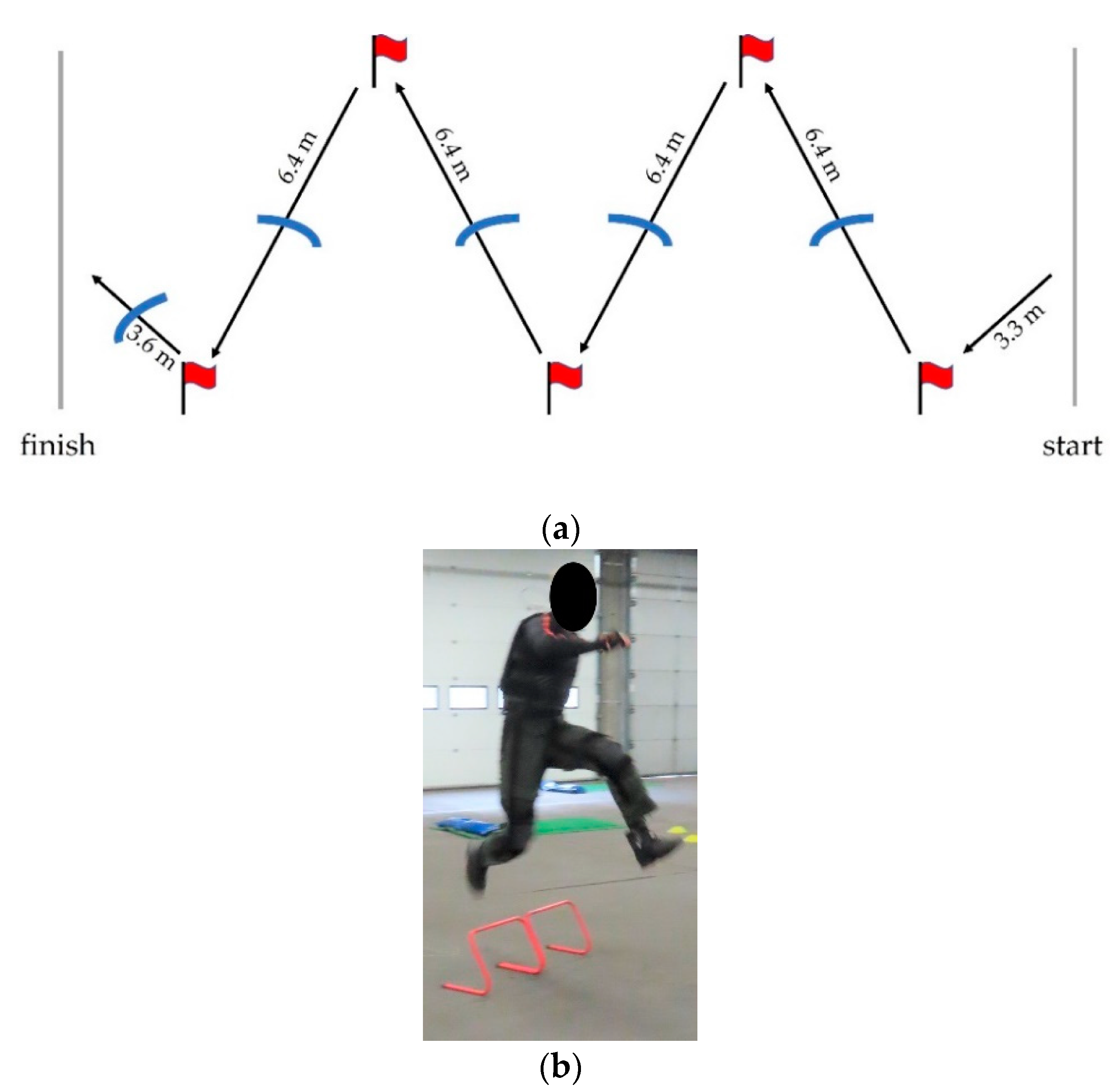

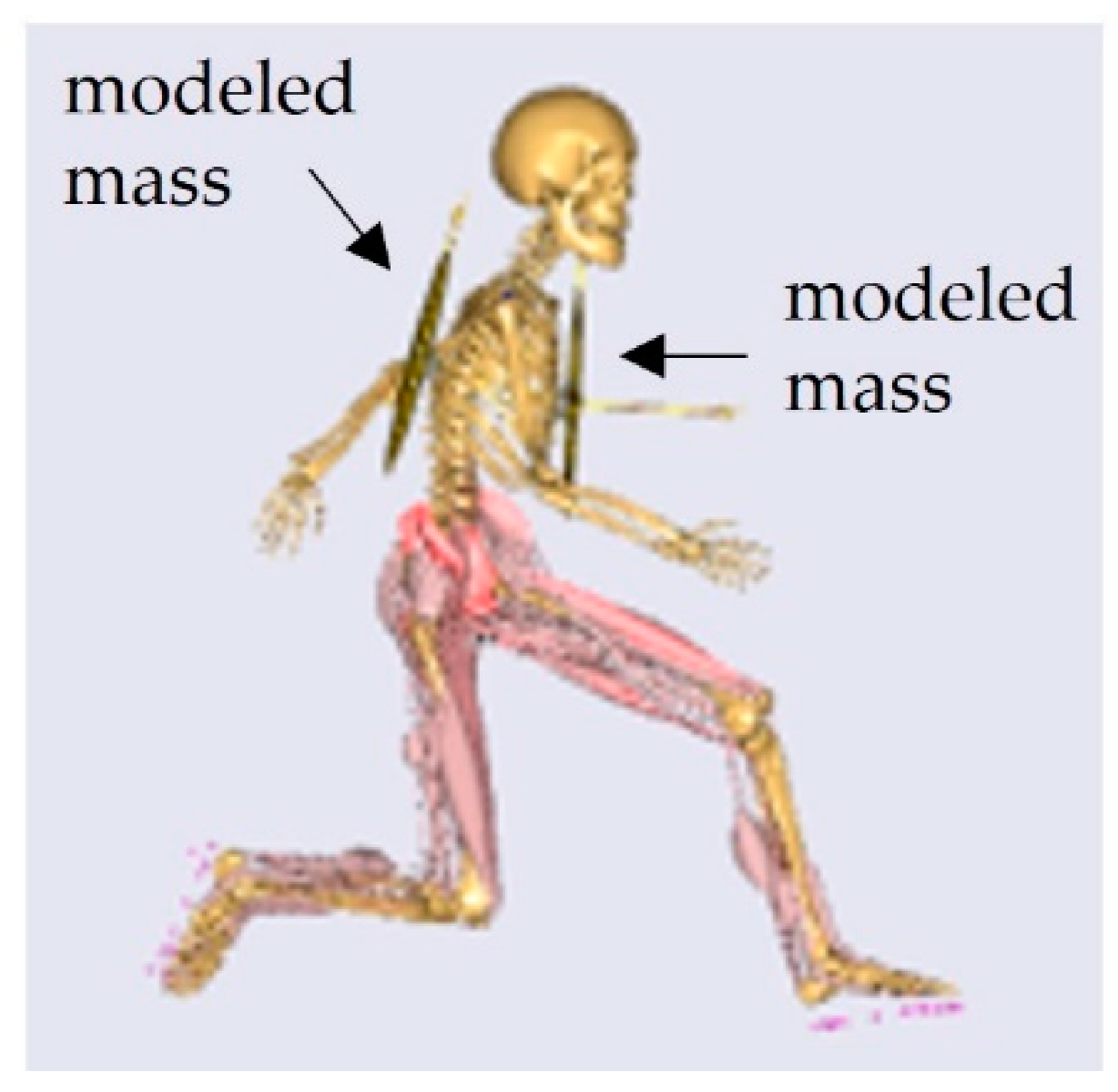

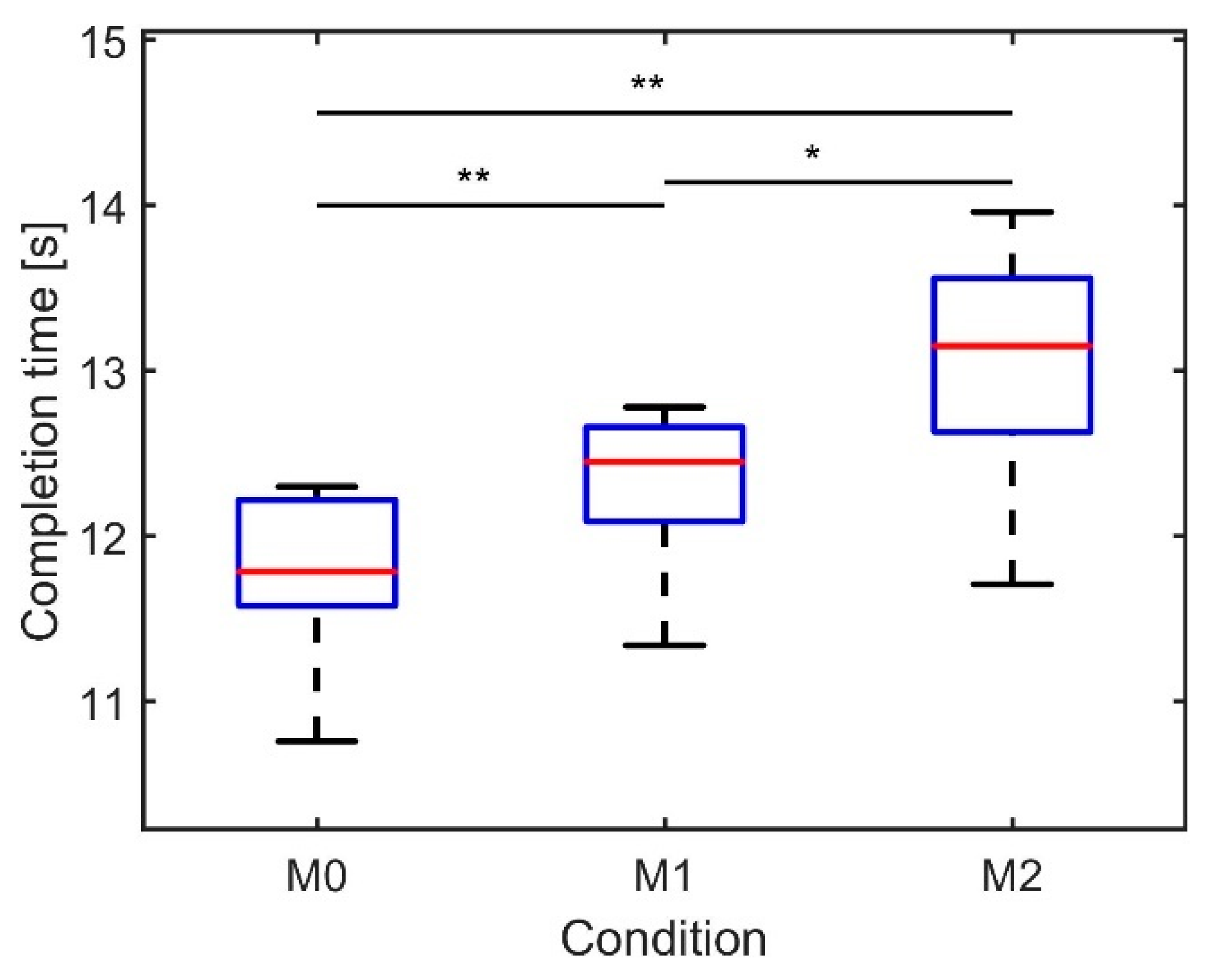
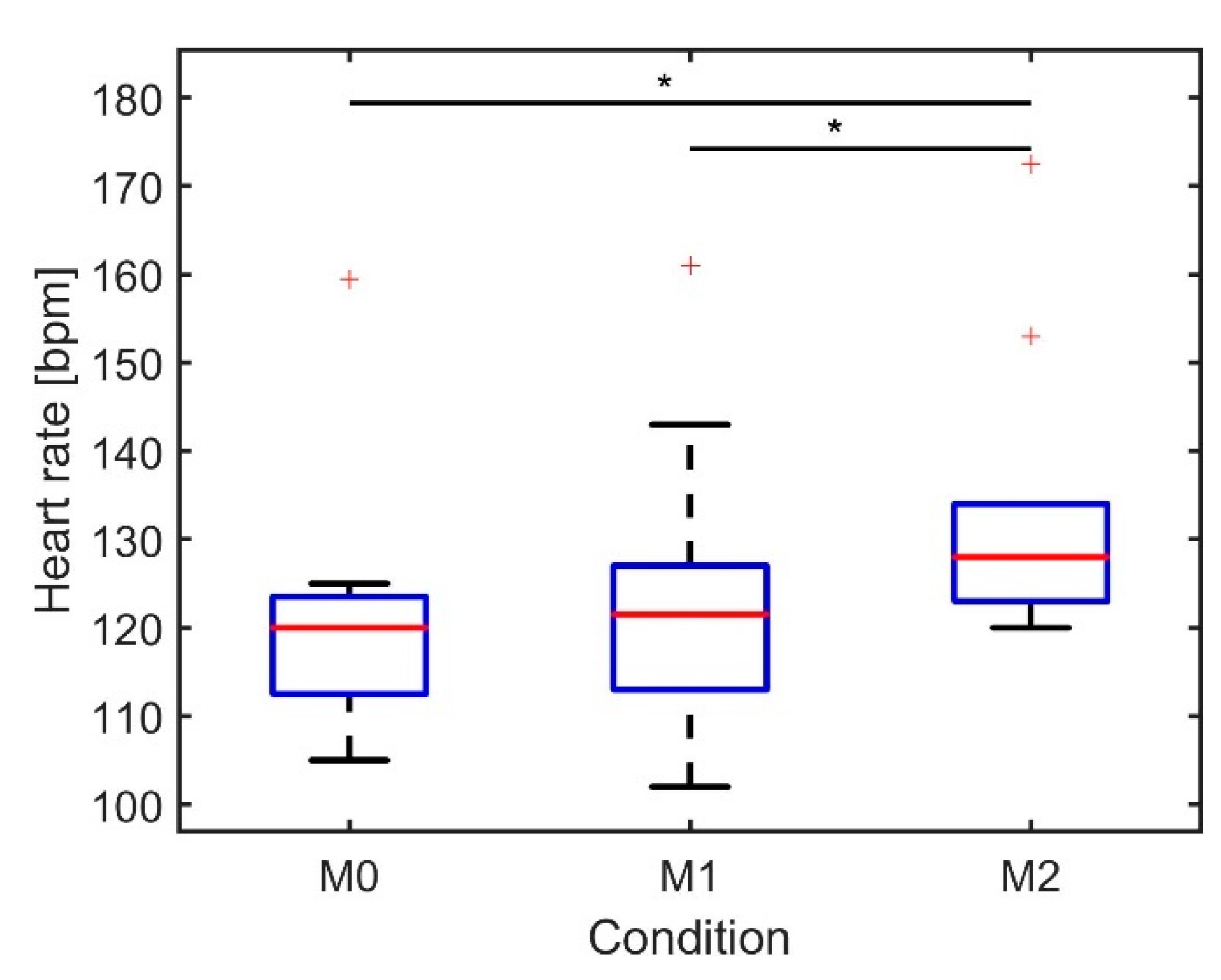


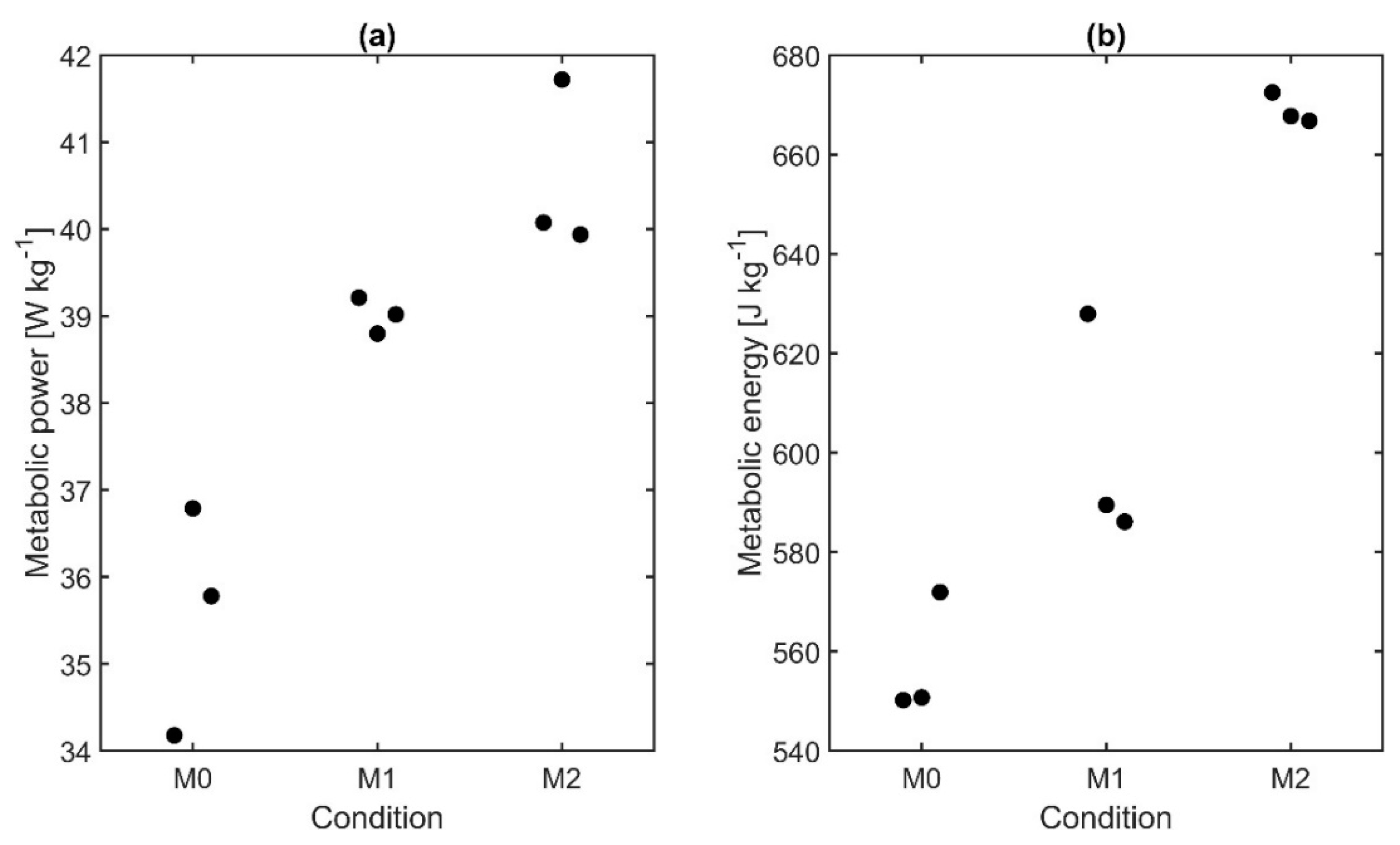



| Measure | M1 | M2 |
|---|---|---|
| Weight on chest () (kg) | 5.2 | 15.6 |
| Weight on back () (kg) | 10.4 | 15.6 |
| Width () (m) | 0.31 | 0.31 |
| Height () (m) | 0.30 | 0.30 |
| Thickness on chest () (m) | 0.0125 | 0.0375 |
| Thickness on back () (m) | 0.0250 | 0.0375 |
| Metric | M0 | M1 | M2 | p | M1 rel. M0 | M2 rel. M1 | M2 rel. M0 |
|---|---|---|---|---|---|---|---|
| CT [s] | 11.78 ± 0.46 † | 12.32 ± 0.46 † | 13.08 ± 0.68 † | <0.000 | 0.665 (5.6%) ** | 0.700 (5.6%) * | 1.37 (12%) ** |
| HR [bpm] | 120 + 55 | 122 + 59 | 128 + 53 | <0.000 | 2 (1.3%) | 7 (5.3%) * | 8 (6.7%) * |
| Metric | M0 | M1 | M2 | p | M1 rel. M0 | M2 rel. M1 | M2 rel. M0 |
| Energy expenditure | |||||||
| [W kg−1] | 35.8 + 2.61 | 39.0 + 0.41 | 40.0 + 1.78 | =0.050 | 3.24 (9.1%) | 1.05 (2.7%) | 4.29 (12%) |
| [J kg−1] | 551 + 21.7 | 589 + 41.8 | 668 + 5.71 | =0.050 | 38.7 (7.0%) | 78.3 (13%) | 117 (21%) |
| Muscle parameters of gluteus maximus muscle | |||||||
| [W kg−1] | 0.184 + 0.0747 | 0.291 + 0.0488 | 0.319 + 0.0391 | >0.050 | 0.107 (58%) | 0.0282 (9.7%) | 0.135 (73%) |
| [J kg−1] | 40.9 + 1.10 | 48.9 + 1.41 | 55.8 + 3.44 | =0.050 | 8.05 (20%) | 6.93 (14%) | 15.0 (37%) |
| [N] | 124 + 6.90 | 154 + 7.12 | 183 + 6.86 | =0.050 | 29.7 (24%) | 29.3 (19%) | 59.0 (48%) |
| [cm s−1] | −0.288 + 0.130 | −0.770 + 0.294 | −0.989 + 0.158 | =0.050 | −0.482 (168%) | −0.219 (28%) | −0.701 (244%) |
| Muscle parameters of vastus lateralis muscle | |||||||
| [W kg−1] | 0.575 + 0.0416 | 0.582 + 0.126 | 0.622 + 0.0399 | >0.050 | 0.0073 (1.3%) | 0.0399 (6.9%) | 0.0472 (8.2%) |
| [J kg−1] | 41.8 + 4.03 | 44.7 + 3.08 | 48.9 + 0.751 | =0.050 | 2.87 (6.9%) | 4.22 (9.4%) | 7.09 (17%) |
| [N] | 316 + 18.9 | 365 + 71.7 | 397 + 5.88 | =0.050 | 48.9 (16%) | 32.0 (8.8%) | 81.0 (26%) |
| [cm s−1] | 0.113 + 0.515 | 0.127 + 1.13 | 0.958 + 0.205 | >0.050 | 0.0141 (12%) | 0.830 (652%) | 0.845 (745%) |
| Kinematic parameters | |||||||
| [deg] | 9.04 + 0.377 | 8.58 + 1.01 | 7.79 + 1.45 | >0.050 | −0.464 (−5.1%) | −0.788 (−9.2%) | −1.25 (−14%) |
| [deg] | 37.9 + 2.82 | 29.0 + 11.5 | 28.4 + 2.84 | >0.050 | −8.82 (−23%) | −0.663 (−2.3%) | −9.48 (−25%) |
| [cm] | 101 + 1.24 | 99.2 + 0.66 | 99.4 + 0.110 | >0.050 | −1.42 (−1.4%) | 0.230 (0.23%) | −1.19 (−1.2%) |
| [cm] | 49.1 + 2.40 | 46.7 + 4.44 | 44.5 + 1.84 | >0.050 | −2.42 (−4.9%) | −2.15 (−4.6%) | −4.57 (−9.3%) |
Publisher’s Note: MDPI stays neutral with regard to jurisdictional claims in published maps and institutional affiliations. |
© 2021 by the authors. Licensee MDPI, Basel, Switzerland. This article is an open access article distributed under the terms and conditions of the Creative Commons Attribution (CC BY) license (https://creativecommons.org/licenses/by/4.0/).
Share and Cite
Kessels, I.; Koopman, B.; Verdonschot, N.; Marra, M.; Gijsbertse, K. The Added Value of Musculoskeletal Simulation for the Study of Physical Performance in Military Tasks. Sensors 2021, 21, 5588. https://doi.org/10.3390/s21165588
Kessels I, Koopman B, Verdonschot N, Marra M, Gijsbertse K. The Added Value of Musculoskeletal Simulation for the Study of Physical Performance in Military Tasks. Sensors. 2021; 21(16):5588. https://doi.org/10.3390/s21165588
Chicago/Turabian StyleKessels, Ilona, Bart Koopman, Nico Verdonschot, Marco Marra, and Kaj Gijsbertse. 2021. "The Added Value of Musculoskeletal Simulation for the Study of Physical Performance in Military Tasks" Sensors 21, no. 16: 5588. https://doi.org/10.3390/s21165588
APA StyleKessels, I., Koopman, B., Verdonschot, N., Marra, M., & Gijsbertse, K. (2021). The Added Value of Musculoskeletal Simulation for the Study of Physical Performance in Military Tasks. Sensors, 21(16), 5588. https://doi.org/10.3390/s21165588







